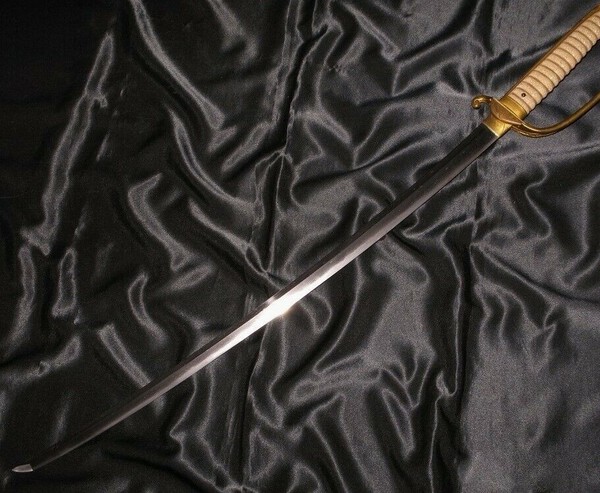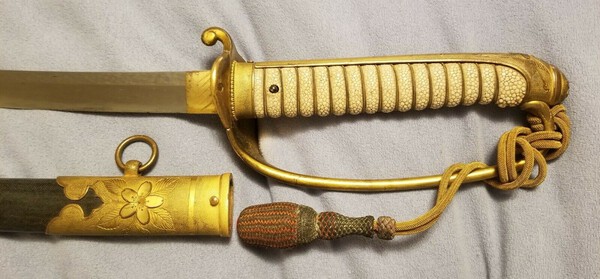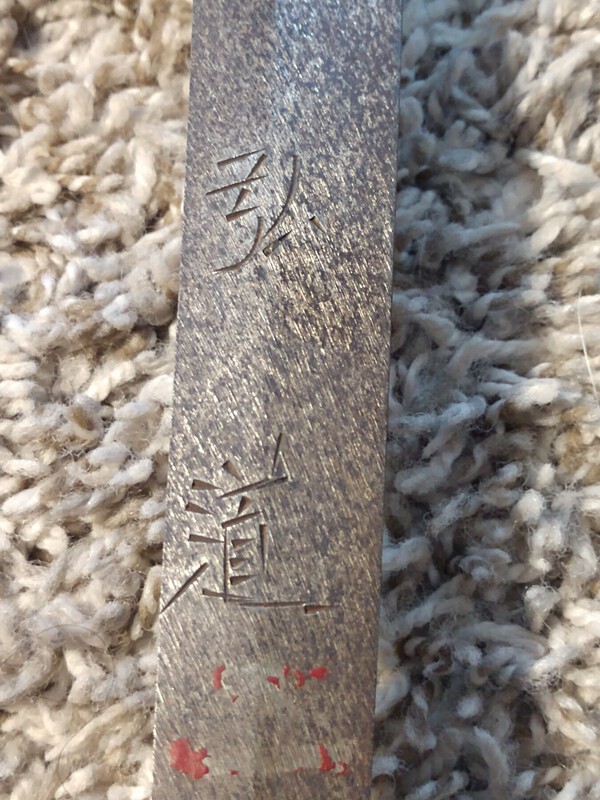-
Posts
1,253 -
Joined
-
Last visited
-
Days Won
8
Content Type
Profiles
Forums
Events
Store
Downloads
Gallery
Posts posted by DTM72
-
-
Steve,
Looking at the two examples in Slough's book, there are variations between the two shown. The blade pictured shows even a third variation. Gimei? Maybe, maybe not. As has been said on here many times, buy the blade, not the signature. If the blade, and koshirae, speak to you, then buy it. In just my humble opinion, there is not a great benefit to take a mumei Showato or low to mid-grade gendaito and fake a WWII smith's name.
All the best.
-
 1
1
-
-
23rd generation Fujiwara Kanefusa made this
-
 1
1
-
-
Found an odd stamped Type 0 on eBay with markings on the back edge of the nakago. Thought you might want to make a note of it.
-
 1
1
-
-
Bringing this show to the top. Just under 2 months away. Who plans to attend? Just made my travel arrangements to attend...not exhibit or sell.
-
Here in the Southern USA, we have "Waffle House". You can get waffles in the North and they are decent. You can get waffles on the West coast but they ruin them with fruit and other crap. All still waffles though. Don't get me started on the taters...scattered, smothered, covered, chunked, diced, topped, peppered, capped, and the newest is countried.
-
 1
1
-
-
Chris,
As a previous resident of Indiana, this is one of the few things I regret about moving far South from there. If I were still a resident, I would 100% attend and participate in the meetings. I feel that you are doing a great service to collectors and helping to spark new interest into our passion/hobby. Looking at the website, I have nothing negative to say, and think it is a great start.
Wishing you and the other members great sucess!
Dan
-
 2
2
-
-
The problem has been from Japan into the USA. the items clear customs, then come-up missing.
-
-
It looks to be machi-okuri, but the end of the nakago does not have the normal suriage straight-cut appearance.
-
 1
1
-
-
I think he is referring to an Apple Air Tag or other RFID tag.
-
2 hours ago, francois2605 said:
@Ray Singer is in Florida, you may want to contact him
I also agree that Ray Singer is the best to go to in S. Florida. He has alot of experience with WWII blades.
-
I cringe every time I see this photo. There are other photos of this same guy, holding the same sword with his bare fingers on the blade.
Also cringeworthy to see all the swords just stacked on top of eachother. (My kids would be happy to see that I used "cringeworthy" in a sentence.)
-
 2
2
-
-
41 minutes ago, Dark Regent said:
Unfortunately, all I have is the blade and the scabbard. So, I'm also trying to figure out what to do with it, in terms of maybe finding a tsuka, etc. to go with it. I know it's not really valuable but it is a piece of history.
Looks like you will need;
habaki (collar)
seppa (spacers)
tsuba (hand-guard)
tsuka (handle)
Habaki and tsuka are custom fitted to each blade. Seppa and tsuba can be filed open or punched to close slightly. Best thing you could do is attend a military antique show or a Japanese sword show. Many dealers have extra habaki, seppa, tsuba and tsuka that you can try to fit. Roll of the dice though.
-
looks like Kato Norisada
加
藤
則
貞
-
 2
2
-
-
-
30 minutes ago, Bruce Pennington said:
Wow Dan, everything about that is fabulous! Even has the folding handguard.
Much appreciated Bruce!
Now to figure out what belt would have been worn with it...
-
Always wanted a Navy Kyu and finally found a nice one. Even has the tassel!
NTHK papers say the blade was made in the Eisho era about 1504-1521. attributing it to the Uda Kunimune.Nagasa = 25 1/2". (64.7cm)Blade thickness at habaki is 3/16" (6.77mm)Width at habaki 1" (2.54cm)Width at Yokote is 9/16" (14.2mm)Sori is 3/4" (19mm)-
 1
1
-
 1
1
-
-
-
-
Mark, I had one like that condition. I used some tsubaki oil and a bamboo chopstick, broken in half. I used the rough break end to rub on the surface and it removed the loose rust, but not the patina.
-
Wel at least no one has called it a "Marine Landing Force" or "Naval Landing Force" sword. I've also heard them referred to as a "Pattern 44"...which is incorrect too.
-
 1
1
-
 2
2
-
-
I 100% plan to attend!
-
11 hours ago, Krystian said:
Number 5 is sold.
I hope it was to FZ1, he ahs been looking for a tsuba like that.
-
@FZ1 Look at #5
-
 1
1
-
 1
1
-


.thumb.jpg.bc10b59027a00aa142dce0349f3ba9e0.jpg)










Fake Russo-Japanese saber?
in Military Swords of Japan
Posted
Some of the early Type 19's had a traditional bamboo mekugi AND a brass sakura threaded mekugi that goes in that hole. (See pics below) Need to see pics of the nakago to confirm. I owned one like this, but later sold it to someone who made me an offer I could not refuse. The original brass sakura mekugi could have been damaged or lost and a bamboo mekugi inserted. Keep this in mind if you go to remove the tsuka.
I agree with Gilles that this is authentic. The parade sabres have a slightly curved handle whereas the nihonto bladed versions have a straight handle to accomodate the nakago. The same' on the handle appears to have been originally black and has worn nicely. The wire wrap is in tact as well. Notice the center belly node of the same' towards the rear of the handle.
Tough to tell from the pics, but the shinogi appears to be high and the blade width looks to taper towards the kiaaski (fumbari). Leads me to believe this could be a koto period blade. Again, provided photos leave a bit to be desired. I would be interested to see the nakago to see what the blade really is.
Worth $500? I would say yes. This type of mounting (Especially early like this one) is getting harder to find. Perform your due diligence and examine the blade closely for hagire, fukure, and if you can see the hamon at all, look for tiredness. (Hamon dropping off the edge of the blade).
On a side note, never could identify the backstrap decorations per F&G, Dawson, or any other ref material. Guessing it's an early version of the field officer grade decoration.
All the best.